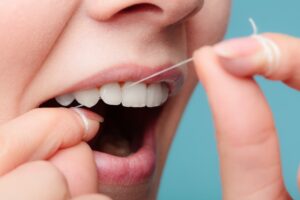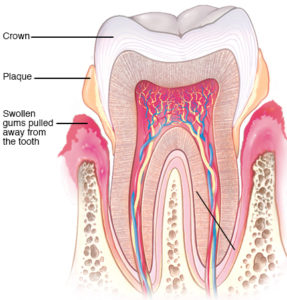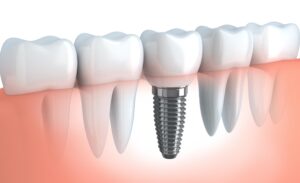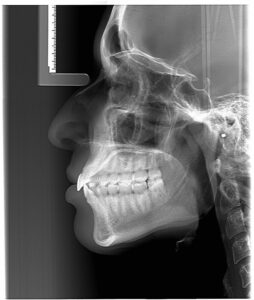Header logo
header top contact widget
Tooth Replacement
Healthy Gums Advantageous To A Healthier YOU!
Posted on Apr 22, 2024 by William J. Claiborne, DDS MS
Periodontal (gum) disease and subsequent tooth loss has damaging effects to an individual, far beyond the mouth. When this was suspected decades ago, it prompted national agencies to track the oral health of the U.S. population. Using this extensive data, studies have revealed some interesting statistics, including how various age groups fare when it comes to oral wellness.
The following is mostly information pulled from the National Institutes of Health’s (NIH) “Oral Health In America” report. Released in December 2021, the findings were the culmination of years of research assembled by more than 400 contributors.
On a positive note, the percentage of Americans who have experienced tooth loss has declined since the 1970’s. As of 2016, complete tooth loss has fallen by more than 75% for adults between the ages of 65 – 75 years. Unfortunately, there is not good news when it comes to tooth decay – for nearly any adult age group.
For adults between the ages of 20 – 64, cavities have affected 90% and gum disease exists for nearly 50% of adults aged 45 – 64 years. This should be a concern for every American. This is because research has determined that the bacteria of periodontitis (advanced gum disease) can trigger or worsen a long list of serious health problems.
The list includes:
• Stroke
• Coronary Artery Disease
• Arthritis
• Diabetes
• Preterm & low birth weight babies
• Some Cancers (including oral and pancreatic)
• Alzheimer’s disease
• Impotency, Erectile Dysfunction (ED)
• Prostatitis (elevated PSA levels)
In addition to poor oral hygiene routines at home and avoiding regular dental cleanings and exams, high-risk behaviors (such as use of tobacco, opioids, and alcohol) accentuate the risks of gum disease.
Although gum disease can begin without obvious signs or symptoms, the most commonly noticed are:
• Red, swollen or tender gums
• Seeing blood in the sink when brushing
• Receded gums
• Loose or separating teeth
• Pus pockets on gum tissues
• Sores in the mouth
• Persistent bad breath
While the report found that there are stark differences in adult groups who had less access to having regular oral health care, disparities also stem from underlying economic, demographic, and societal inequities.
Below are some of the oral health variations pertaining to certain groups.
ADOLESCENTS
During the past 20 years, the percentage of adolescents (ages 12 − 19) having at least one molar with a sealant applied has nearly tripled, from 18% to 48%. That’s a good thing. Even so, there has been no decline in untreated tooth decay in adolescents since the last surgeon general’s report twenty years ago.
High caries (cavities in teeth) experienced in early childhood is the strongest indicator of caries problems that will be experienced in adolescence and adulthood. This means that when the factors contributing to developing cavities in childhood persist, the incidence of caries affecting permanent teeth will continue to increase during adolescence. Likewise, misalignment of teeth that exist or develop during adolescence can substantially impact eating, speech, gum health, and even psycho-social development. (Imagine a teen with teeth so mispositioned that they are ridiculed by peers.)
OLDER AMERICANS
There is good news for our older population (Americans over the age of 65). Their overall oral health has significantly improved over the past two decades with fewer teeth being extracted. Additionally, the proportion of the population with edentulism (no remaining natural teeth) is at an all-time low.
The not-so-great news… tooth loss remains a problem for older adults. Today, 1 in 6 Americans have no remaining natural teeth. At this rate, by the year 2030 (just 6 years from now), the 65-&-over age group without teeth will increase to 1 in 5.
For adults over the age of 75, the challenges are even greater. Over 54% have fewer than 21 remaining teeth with the number increasing to 80% for those living in poverty. With age also comes the increased prevalence of systemic diseases that may impact the mouth, making older adults more susceptible to oral health issues. (This includes heart disease, diabetes, arthritis, etc.)
Fortunately, things are moving in a positive direction for older adults, with more keeping their teeth than any previous generation. This has largely been the result of having increased attention on the benefits of prevention and improvements in treatments for gum disease and cavities, along with a decrease in the rate of smoking. (About 8 of every 100 adults – 8.3% – of adults 65 years and older were reported to smoke in 2023.)
WOMEN
Women have unique oral health concerns due to changing hormone levels based on menstrual cycles, pregnancy, and menopause. These fluctuations can raise the risk of oral problems that effect teeth or gums. Health issues, such as diabetes, can also affect the oral health of females.
To keep your teeth healthy, it is important to remove dental plaque. This is a sticky, colorless film of bacteria that coats teeth and gums. Plaque buildup can cause tooth decay and gum disease.
Even teeth that already have fillings are at risk for tooth decay. Plaque can build up underneath a chipped filling and cause new decay. And if there are areas in your mouth where your gums have pulled away from the teeth (known as receded gums or gum recession), the exposed tooth roots can decay as well.
It’s important – for all ages – to be committed to their oral hygiene time at the sink, at least twice a day. Devoting these minutes to the care of your teeth and gums will pay off in future years, helping to minimize costs for dental repairs and time in treatment. And, when early ages get into the habit of an oral care routine at home, they are more likely to carry that into adulthood.
Here are some easy brushing tips:
• Use fluoride toothpaste, which is an ingredient of many products. Fluoride protects teeth from cavities, helping to strengthen the tooth’s hard outer surface – the enamel.
• Angle the bristles toward the gumline so they can sweep away bacteria between the gums and teeth.
• Brush gently using small, circular motions. Do not scrub hard back and forth, which can wear down tender gum tissues and wear away tooth enamel.
• Brush all sides of each tooth and the tops (where debris and bacteria can hide within grooves).
• Brush your tongue, especially towards the back where the majority of bacteria embed. Swish well with water at least twice afterwards.
Cleaning between teeth to remove plaque is also part of a good oral hygiene routine. If plaque is not removed, some of it can harden below the gum line and irritate the gums. The gums become red, swollen, and may bleed easily. These are signs of gingivitis. Gingivitis caused by plaque buildup is a mild form of gum disease, and you can usually reverse it with daily brushing and flossing.
If plaque stays on your teeth for too long, it can harden. This hardened plaque is called calculus, or tartar. The only way to remove tartar is to have your teeth cleaned by a dentist or dental hygienist. If the tartar is not removed, the gingivitis can get worse and lead to more severe gum (periodontal) disease. In advanced stages, gum disease causes sore, bleeding gums; painful chewing problems; loose teeth; and even tooth loss.
Here are some additional ways to keep a healthy smile with practical measures.
- Floss to remove plaque, and food particles, from between your teeth.
- Visit the dentist for routine check-ups and professional cleaning. If you are at a high risk for tooth decay (for example, if you have a dry mouth because of medicines you take), your dentist or dental hygienist may give you a fluoride treatment, such as a varnish or foam during the office visit.
- Drink fluoridated water. Drinking water with the right amount of fluoride protects your teeth throughout the day.
- Don’t smoke. Smoking increases your chance of gum disease. If you smoke and want to quit, there are many resources to help you: FDA’s Center for Tobacco Products, CDC’s Quit Smoking website, and the BeTobaccoFree.gov website.
- If you are planning to become pregnant, have a dental checkup. Because of hormonal changes, pregnant women may develop gingivitis and experience gums that are swollen and bleed easily. During pregnancy, it is especially important to practice good oral hygiene to maintain the health of your gums.
- Eat a diet that is low in sweets and sugary drinks.
A periodontal specialist is your best advocate in restoring or maintaining healthy gums. In addition to the skills in treating all stages of gum disease (from gingivitis to periodontitis), a periodontist specializes in the selection and placement of dental implants.
If you have signs or symptoms that may be indicative of gum disease, please know this disease will only worsen without treatment. Call 828-274-9440 to schedule an appointment or ask to begin with a consultation.
If dental fear is a concern, we can discuss oral or IV sedation options. These are administered safely with skilled staff members who use advanced safety equipment throughout your care.
Additionally, if you’ve delayed care due to cost, we office several payment plans that many patients find helpful. These plans can break costs into monthly payments, often with no down payment required.
Sources:
https://www.nidcr.nih.gov/health-info/oral-hygiene
https://www.nidcr.nih.gov/research/oralhealthinamerica/section-2b-summary
https://www.nidcr.nih.gov/research/oralhealthinamerica/section-3b-summary
https://www.nidcr.nih.gov/research/oralhealthinamerica/section-3a-summary
https://www.womenshealth.gov/a-z-topics/oral-health
https://www.cdc.gov/tobacco/data_statistics/fact_sheets/adult_data/cig_smoking/index.htm
What You May Be Doing To Increase Potential For Gum Disease
Posted on Apr 11, 2024 by William J. Claiborne, DDS MS
There’s a saying: “We don’t know what we don’t know.”
That applies to so much in life. With all good intentions, adults go about their days feeling they are doing what is right. However, we occasionally learn that what we thought was right is to our detriment.
For example, decades ago, people felt that rigorous scrubbing of teeth with a hard toothbrush and baking soda was a good way to clean your teeth. We now know that the hard bristles and abrasive substances can wear down tooth enamel and scrub away tender gum tissues.
And, there are ways that we actually – and unconsciously – add to the risks for developing periodontal disease.
Over the years, research has continuously shown that the bacteria of periodontal disease can have a number of harmful effects – in the mouth and further. Because these inflammatory bacteria can enter the bloodstream and travel throughout the body, research has shown that they can activate or worsen a number of serious health problems. These include:
– heart disease
– stroke
– Alzheimer’s disease and dementia
– arthritis
– diabetes
– preterm babies
– erectile dysfunction (ED)
– some cancers (including lung and pancreatic)
– obesity
Signs of gum disease include bleeding or sore gums, persistent bad breath, receded gums, and/or gums that are red rather than a healthy pink. These are warning signs since gum disease will only worsen without treatment.
As gum disease progresses, gums begin to pull away from the base of teeth, gums become very tender and bleed easily when brushing, pus pockets form on gums and teeth may shift or loosen.
Unfortunately, gum disease is ignored too often by adults in the U.S. The CDC estimates that over 47% of Americans have some level of gum disease, which is also the leading cause of tooth loss.
Bacterial overload can leave the body’s natural defense response, white blood cells, unable to conquer the infection. Thus, bacteria overload in the mouth triggers an inflammatory reaction begins, which is the beginning of gum disease.
Below are things that can increase the risk for gum disease, some of which you may not realize are contributors:
Aging: Studies have indicated that the incidence of periodontal disease increases as we get older. Over 70% of adults who are aged 65 and older have some form of gum disease.
Some Existing Health Problems: People who have diseases such as cancer or heart problems already have weaker immune systems. When the bacteria of gum disease enter the bloodstream through tears in oral tissues, harmful clotting factors and proteins can occur elsewhere in the body. Research has linked gum disease bacteria with heart disease, diabetes, stroke, preterm babies, and memory loss.
Dry Mouth: Smoking, certain medications, drinking alcohol and aging all contribute to a dry mouth. The saliva in your mouth plays an important part in removing food particles and bacteria. When insufficient saliva cannot cleanse the mouth adequately, bacteria buildup results.
Stress: It has been proven that people who endure long-term stress have a greater risk for developing diseases such as cancer, hypertension and even gum disease. Stress takes a toll on the body’s entire operation, weakening its ability to fight infection.
Medications: The side effects of some drugs can dry out oral tissues and even weaken the density of bones, opening the door for gum disease. Like your physician, your dentist should have an up-to-date list of all medications you take, including herbal supplements.
Grinding Teeth: When you grind and clench your teeth during sleep, the teeth wear down and connective oral tissues are weakened. When the tissues surrounding your teeth are vulnerable, your entire jaw bone area is exposed to certain infections, which can lead to gum disease.
Genetics: Because of genetics, you can be predisposed to develop gum disease. Research indicates that 30% of the population may be genetically susceptible to gum disease.
Gender: Periodontal disease occurs more in men than women (56% vs. 38%).
Smoking: Smoking dries out the tissues in the mouth, increasing one’s susceptibility to calculus. Research shows that smokers lose more teeth than nonsmokers and typically require longer healing times after treatment with results that are less predictable.
A periodontist is a specialist in the treatment of all stages of gum disease and in the placement of dental implants. He or she is the expert who can help to restore a bacteria-burdened “oral cavity” to a healthy state.

Dr. William Claiborne,
Biltmore Periodontics
In our Asheville periodontal dental office, we feature some of the most advanced technology in the industry. The patient benefits from these through diagnoses that are exact, more conservative treatment, and having reduced healing time. This also can mean there is less discomfort.
One of the features we provide is the LANAP Protocol Using Periolase MVP-7. LANAP (an acronym for Laser-Assisted New Attachment Procedure) is amazing technology that more efficiently and effectively treats periodontitis (advanced gum disease) with the PerioLase® MVP-7™ laser. As a minimally invasive (non-surgical) treatment for moderate to severe periodontal disease, LANAP has even been found to stimulate bone regrowth in damaged areas.
If you are experiencing symptoms of gum disease, call 828-274-9440. In our state-of-the-art Asheville periodontal dental office, our patients are treated with respect, compassion and a gentle touch. New patients are always welcome.
If dental fear has kept you from having regular dental care and you’re experiencing symptoms of gum disease, consider starting with a consultation. During this time, we can discuss comfort options, including oral and IV sedation (“twilight sleep”). Referrals are not required.
Avoid Dental Implant Failure
Posted on Apr 04, 2024 by William J. Claiborne, DDS MS
There are reasons to go to an expert for certain things. For example, I’d never try to do electrical work around my house on my own; I’d call an electrician.
When it comes to dental implants, there are also reasons to seek out an “expert.” In this article, I’ll explain why it’s best to have your dental implants selected and placed by a periodontist.
First, let’s look at the structure of an implant. Serving as a replacement for a missing tooth, the implanted portion is a titanium screw that is positioned into the jawbone. Over the course of 3-6 months, the jawbone grows around the implant, securing it in place. It can now support an artificial tooth or crown.
Dental implants have many benefits when it comes to restoring biting/chewing/speaking function and smiling appearance, including:
- enhancing the appearance of a smile
- improving biting and chewing function
- stabilizing surrounding teeth and jaw tissue
- halting the process of bone loss, known as resorption
- an increased quality of life for many people
Dental implants have an excellent success rate – 90-95%. However, there are instances where a dental implant can fail.
Dental implant complications can occur from infections, gum recession, and nerve and tissue damage. There is also a higher risk of implant failure for individuals who smoke or have diabetes, gum disease, have radiation therapy to the jaw area or take certain medications.
A periodontal specialist has advanced training and skills in the diagnosis and placement of all types of dental implants. This means that this dental specialist can determine which implant system will work best for your individual needs. For example, a person who has lost a great deal of bone mass may only be a candidate of certain implant types or may need a sinus lift prior to placement. A periodontist can make these determinations so your potential for implant success is higher.
One of the most common causes for implants failure is due to an infection at the implant site. Because a periodontist specializes in the care of gum tissues in the mouth, he or she can take measures to treat the infection at early stage to resolve the problem. However, in some cases, treating the infection may require implant removal in order to reach the infected bone tissue.
Using advanced skills, a periodontist can also assess your gum health prior to implant placement. He or she can pretreat any periodontal diseases so the implant has a healthy foundation. When the gum tissues around the implant are inflamed or have receded, the implant is at risk for entry of bacteria into the area where it is implanted.
After the implant is placed, it should fuse with the bone. A complication that prevents this may require the dental surgeon may remove it. Fortunately, after the implanted area is restored to a healthy state, the implant procedure can be redone.
Another benefit in using a periodontal specialist for implant placement is in their in-depth understanding of the nerves and tissues surrounding the jaw bones. There is a risk for failure when a dental implant is placed too close to a nerve. For example, there is a nerve that runs horizontally through the lower jaw. If the implant is placed in close proximity, it can cause numbness, tingling, or pain.
Nerve or tissue damages can result in:
-
- numbness on the side of the implant, including the lower lip and chin
- persistent pain or discomfort
- tingling, tickling, or burning sensations in the gums and skin
While precision placement (depth, position and angle) is a bonus of a periodontist’s skills for implant patients, our Asheville periodontal dental patients have the benefits of advanced technology. Our Computerized Dental Implant Placement system is designed for pre-surgical positioning of dental implants that uses a 3D model of the patient’s jaw.
Once the implant type is selected, a template is developed for optimal treatment success, even for complex cases. This minimizes disruption of gum tissues and targets implant placement at ideal depths and angles. Thus, treatment success rates are higher with faster (and more comfortable) healing time.
An example of this precision placement guidance in with upper dental implants. With declined bone mass of the upper jaw (typically from years of missing tooth roots), the sinus cavities can hover too close to the position(s) where implants are to be placed. In these cases, we can perform a sinus lift.
Should the dental implant protrude into the sinus cavity, the sinuses can become inflamed, causing:
- pain, tenderness, or swelling around the cheeks, eyes or forehead
- nasal blockage, often with green or yellow mucus
- a reduced sense of smell
- headaches
- toothache
- persistent bad breath
Of course, like a natural tooth, excessive force or impact can cause a dental implant to crack or become loose. For example, for people who grind or forcefully clench their teeth (“bruxing”) during sleep may need to wear a bite guard to prevent damage to the implant as well as their natural teeth.
In some instances, it can take up to 5 years for implant-related problems or infections to become apparent to the patient. Any issues that arise around the site of the dental implant should be examined and addressed without delay.
We want your dental implant(s) to last your lifetime and bring you as much eating and laughing pleasure as they are known to give. The best way to ensure the success of a dental implant is to follow the aftercare advice your periodontist and dentist provide.
As with a person’s natural teeth, an implant and the tissues surrounding it require regular cleaning. Daily flossing in the area at least once per day is needed after the gums have healed. Some patients prefer interdental brushes to access areas that are more difficult to reach.
 Regular dental check-ups and appointments for cleanings should occur at least twice a year to ensure the longterm success of your implants. Once a quarter may be advised for some individuals who have higher risks for plaque development.
Regular dental check-ups and appointments for cleanings should occur at least twice a year to ensure the longterm success of your implants. Once a quarter may be advised for some individuals who have higher risks for plaque development.
Optimal comfort for our Western Carolina patients has always been a priority. For many, a desired level of comfort and relaxation includes sedation options. Here, we offer several sedation options, including oral and IV sedation (“twilight sleep”). These are administered safely by an anesthesiologist who uses advanced safety equipment throughout your treatment.
If you are considering dental implants, you may wish to begin with a consultation appointment. During this time, we can explain the vast difference in comfort, treatment time, and success available through our specialized skills and extensive technology.
Call 828-274-9440 to schedule. New patients are always welcome.
As You Age, Avoid A ‘Melting’ Face With Dental Implants
Posted on Feb 26, 2024 by William J. Claiborne, DDS MS
It seems the older one gets, the more conscious he or she is to the need for good health practices. While periodic exams and check-ups are part of this, eating healthy and getting ample exercise are practical ways to support a healthy body.
The same principles apply to oral health. While annual physical exams are needed, regular check ups and dental hygiene cleanings are as well. Through decades of research, “bad” bacteria in the mouth can lead to inflammatory reactions that can offset or worsen a number of health problems far beyond the mouth.
For now, let’s focus on your gum health and the presence of teeth. While natural teeth are the ideal structure for biting, chewing and speaking, the rigors of age – the natural wear and tear – can take its toll on teeth. Decay, gum disease, accidents and certain illnesses can lead to losing a tooth or teeth over the span of a lifetime.
There are several ways to replace a missing tooth (or teeth). A crown-&-bridge is a longstanding method to replace one or several teeth in one area. Or, a partial denture can replace a “scattering” of teeth in the same arch. However, the downside of these oral prosthetics is what’s beneath the gum line.
Your natural teeth are supported by your upper and lower jaw bone, known respectfully as the maxilla and mandible. With these strong, study bones, tooth roots are held securely. Thus, biting and chewing occurs comfortably.
The jaw bones are actually kept healthy by the presence of tooth roots. These roots provide stimulation to the bone as well as nourishment that feeds through the tooth’s interior.
When a tooth is removed, so is the stimulation and nourishment to that area of the jaw bone. Without it, the bone begins to shrink. As it declines in height, the adjacent teeth are more vulnerable to loss. Statistics show that teeth adjacent to areas where natural teeth are missing will be the most likely to be lost next.
This has a domino effect. Partials can replace the presence of teeth above the gum line, but there is nothing to benefit the jaw bones below. Thus, tooth loss continues and can go from a few missing teeth to losing all teeth (being “edentulous”).
According to the Center for Disease Control & Prevention (CDC), 69 percent of adults between the ages of 35 – 44 have lost at least one permanent tooth. By age 50, Americans are missing an average of 12 teeth. For adults between the ages of 65 – 74, 26 percent are missing all of their natural teeth. That’s over one-fourth of the adult population over age 65.
Although dentures and partials mimic the presence of teeth, the jaw bones below are shrinking away, and at a rather rapid pace. The pressure of wearing a denture or partial actually speeds this process up, known as “resorption.”
As these bones decline in mass, deep wrinkles form around the mouth. The corners of the mouth turn downward. The chin takes on a more pointed form and the mouth sinks into the face. The nose seems to get closer to the chin as the jaw bones thin. Jowls form as facial muscles detach from shrinking bone structure.
Changes in facial appearance also take place when bone structures shrink. For example, as the jaw bone thins, deep wrinkles form around the mouth. The corners of the mouth will start to turn down, even in a smile. Jowls form on each side of the face as facial muscles detach from the shrinking bone structure.
As the jaw bone declines further, the chin becomes more pointed and the nose seems to get closer to it. This leads to a collapsed mouth that is known as a “granny look.” This look ages the appearance of an individual far beyond their actual years.
Not to be overlooked is the ability to comfortably bite and chew food. This is essential for the digestive process, since the first stage of digestion begins in the mouth. When adults struggle to eat with a denture or partial, the efficiency of this initial stage of digestion is compromised.
It’s not unusual for adults who have “rocky” or “slippery” dentures to opt for soft foods that dissolve easily in the mouth. These are often carb heavy and lack the nutritional value of a diet that combines healthy proteins, fruits and vegetables.
However, missing teeth or dentures that move when eating can cause other detrimental problems. When people sense their dentures may cause embarrassment when eating, speaking or laughing with others, social involvement can take a hit. According to a 2012 statement by the World Health Organization:
“Oral health is essential to general health and quality of life. It is a state of being free from mouth and facial pain, oral and throat cancer, oral infection and sores, periodontal (gum) disease, tooth decay, tooth loss, and other diseases and disorders that limit an individual’s capacity in biting, chewing, smiling, speaking, and psycho-social well-being.”
As an Asheville periodontist, my dental specialty includes the diagnosis and placement of dental implants. Dental implants are the closest thing to natural teeth.
Dental implants were designed to recreate the presence of natural teeth both above and below the gum line. Because teeth attached to the implants are supported by the jaw bone, the study foundation restores the ability to bite and chew without movement or fear of embarrassing slips.
For patients who are missing a great deal of bone, we offer bone rebuilding that does not require a bone graft. We also perform sinus lifts (when the upper jaw has declined to a significant level) to restore sufficient bone distance between vital structures.
For many of our dental implant patients, their lives become more active with the restored confidence. They become more socially involved, have more self-confidence and higher self-esteem. And the advantages of dental implants over other tooth replacement options are numerous.
• Dental implants are designed to last your lifetime. They do not decay, need root canals or compromise neighboring teeth or bone structure.
• Because dental implants are positioned in the jaw, they recreate stimulation to the bone. This helps to preserve the bone’s mass, halting the pace of jaw bone shrinkage (known as resorption).
• Resorption is what causes changes in one’s facial appearance, aging one’s appearance far older than their actual age.
• Dental implants do not move or slip when eating, speaking or laughing. A denture is designed to fit the contours of one’s gum ridge; contours that exist at the time the denture is made. However, as resorption reduces bone height, the ridge that holds the denture flattens out over time. This is why a denture becomes ‘wobbly’ or ‘slippery.’
• Dental implant treatment is largely determined by the number of implants placed. In most cases, one implant can support more than one tooth. A full arch (all upper or lower) of teeth are typically supported by several strategically-placed implants.
• Unlike a crown-&-bridge, dental implants so not need the support of adjacent teeth. Therefore, it is not necessary to have teeth shaved down for crowning simply to serve as supports for a bridge.
In our Asheville periodontal dental office, we have highly-advanced technology that aids in the diagnosis and placement process of dental implants. These features help to enhance patient comfort, shorten treatment time, and provide optimal results. Advanced technology includes:
– Computerized Dental Implant Placement – an advanced system for pre-surgical positioning of dental implants using a 3D model of the patient’s jaw. Once the implant type is selected, a template is developed for optimal treatment success.
– Cone Beam Imaging – is ideal for diagnoses and treatment planning through images that provide a clear view of the upper and lower jaw (including nerve canals), with rotations that show sagittal, axial, and coronal planes in a process that is quick, painless and at minimal radiation levels.
– Dental Laser – This small, hand-held device is a tremendous asset when it comes to both the health and appearance of gum tissues. Not only does the laser eliminate or greatly minimize bleeding during procedures, it reduces numbing requirements, removes bacteria and easily uncovers gum tissue where dental implants have been placed. Additionally, laser dentistry can beautifully re-contour or repair gum tissue with a precision line.
As a periodontal specialist serving Western NC, I take great pride in the diagnosis and placement of dental implants with each selected based upon the patient’s individual needs and goals. We provide oral or I.V. sedation to ensure a comfortable experience and a friendly, respectful environment.
To schedule an examination appointment or to begin with a consultation, call 828-274-9440. A referral is not always necessary.
Recent Posts
Categories
Archives
- September 2024
- August 2024
- July 2024
- June 2024
- May 2024
- April 2024
- March 2024
- February 2024
- January 2024
- December 2023
- November 2023
- October 2023
- September 2023
- August 2023
- July 2023
- June 2023
- May 2023
- April 2023
- March 2023
- February 2023
- January 2023
- December 2022
- November 2022
- October 2022
- September 2022
- August 2022
- July 2022
- June 2022
- May 2022
- April 2022
- March 2022
- February 2022
- January 2022
- December 2021
- November 2021
- October 2021
- September 2021
- August 2021
- July 2021
- June 2021
- May 2021
- April 2021
- March 2021
- February 2021
- January 2021
- December 2020
- November 2020
- October 2020
- September 2020
- August 2020
- July 2020
- June 2020
- May 2020
- April 2020
- March 2020
- February 2020
- January 2020
- December 2019
- November 2019
- October 2019
- September 2019
- August 2019
- July 2019
- June 2019
- May 2019
- April 2019
- March 2019
- February 2019
- January 2019
- December 2018
- November 2018
- October 2018
- September 2018
- August 2018
- July 2018
- June 2018
- May 2018
- April 2018
- March 2018
- February 2018
- January 2018
- December 2017
- November 2017
- October 2017
- September 2017
- August 2017
- July 2017
- June 2017
- May 2017
- April 2017
- March 2017
- February 2017
- January 2017
- December 2016
- November 2016
- October 2016
- September 2016
- August 2016
- July 2016
- June 2016
- May 2016
- April 2016
- March 2016
- February 2016
- January 2016
- December 2015
- November 2015
- October 2015
- September 2015
- August 2015
- July 2015
- June 2015
- May 2015
- April 2015
- March 2015
- February 2015
- January 2015
- December 2014
- November 2014
- October 2014
- September 2014
- August 2014
- July 2014
- June 2014
- May 2014
- April 2014
- March 2014
- February 2014
- January 2014
- December 2013
- November 2013
- October 2013
- September 2013
- August 2013
- July 2013
- June 2013
- May 2013
- April 2013
- March 2013
- February 2013
- January 2013
- December 2012
- November 2012
- October 2012
- September 2012
- August 2012
- July 2012
- June 2012


